I love economic games, even the ones that I don’t like.
Let me explain. I love games about money. Almost any game, really. The chance to talk about cash? Fantastic. And if a great game is built around that concept, I’m all for it.
I love City of the Big Shoulders. I am hoping I will like 18xx games. I love Magnate: The First City. I love Brick & Mortar. I love the Brass games (although I have a preference for one over the other).
I don’t enjoy Food Chain Magnate; nor do I love Pipeline. But it was very easy to get me to the table to play those games, because, well, money.
Stockpile (2015, Nauvoo Games) is a game that has quickly grown on me. Whenever I have five players together at the same time, Stockpile has quickly become my go-to economic gaming choice. Picking up Stockpile: Epic Edition made too much sense to pass up.
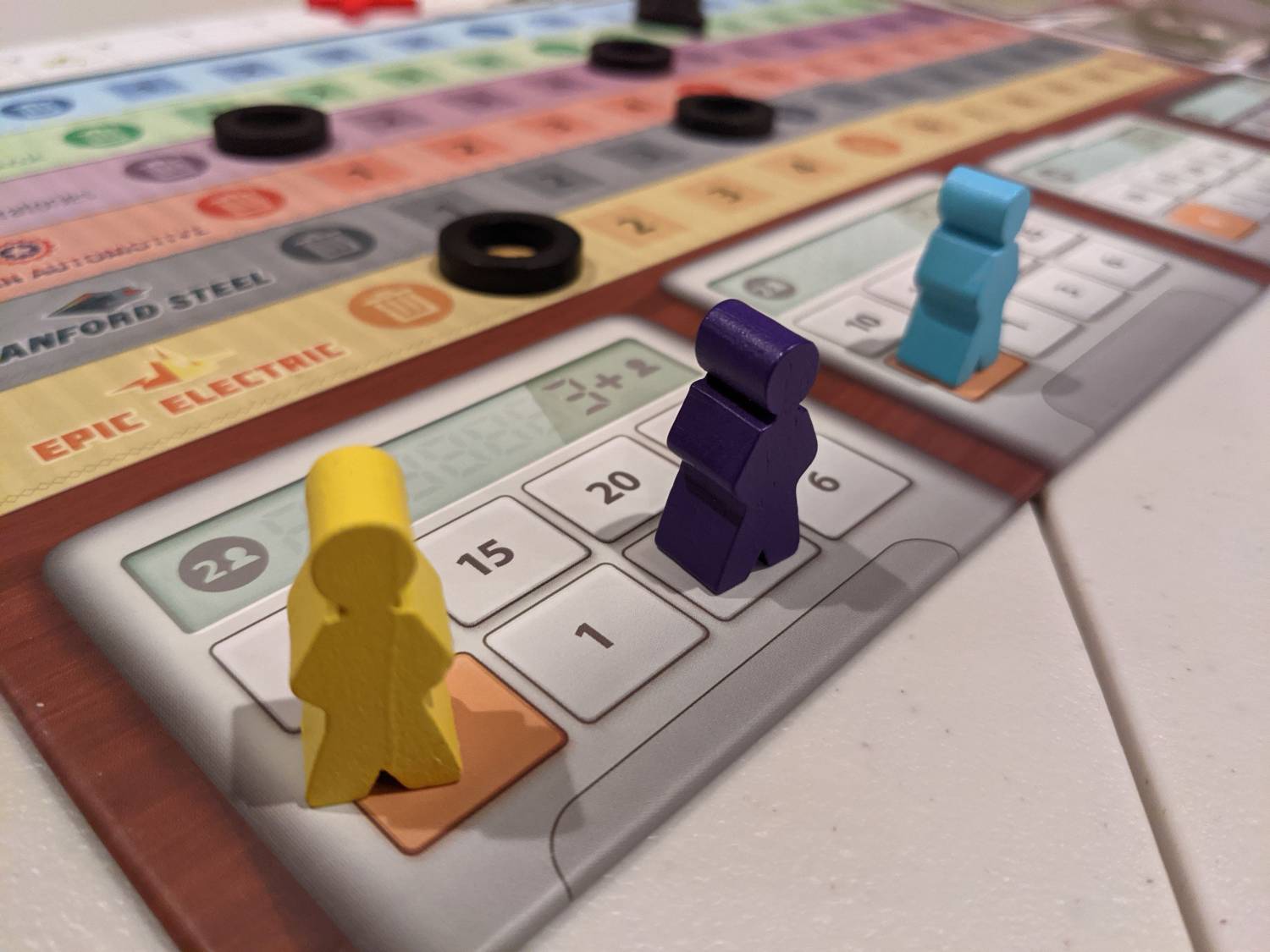
Accessibility Alliteration
Stockpile’s best attribute is how easy it is to get to the table.
Even at a full player count of five, Stockpile plays in about an hour. That’s because the game’s simulation aspect is so straightforward.
It’s the end of the 20th century, and a collection of insider traders are trying to get rich quick. All the traders know something certain about one of the six available stocks each round, because that information is shared on the common board.
Each player also individually knows something about how well one other stock is going to do in that round. The game simplifies the insider information: stocks are tracked so that the value of each stock from round to round is listed in public view in dollar amounts. Then every round each stock will go up or down by as many as five spots on its tracker. Some stocks will pay dividends in a round instead of fluctuating, and those dividends are listed simply as “you get a buck or two this round”. No crazy math is ever needed in Stockpile.
But the drama comes from knowing, and not knowing, where each of the other stocks are going each round.
So, you have some data, thanks to the Information stage of each round. During Supply, players are dealt two cards from a facedown deck of cards, a deck that mostly includes share cards of each of the six stocks. Some other cards are also thrown in there, which might include fees that must be paid during a round, or maybe the ability to publicly manipulate stocks later. Just before this, a single card is added face-up to each of the game’s stockpiles, which will be bid on during the Demand Phase.

Things get juicier: after the face-up card is added from the draw pile to each active stockpile (one each for the number of players in that game), each player adds their two Supply cards to a stockpile or splits the two across two stockpiles, with one card played face up and the other face down.
A game of Stockpile has many great moments, but usually, none is better than the Demand Phase. Using a bidding token, players bid publicly on each pile by placing their token on a dollar tracker space for each stockpile, ranging from $0-$25. You could bid $0, or something else low; as long as no one outbids you, you’ll end up with that pile.
But what if one of the piles has face-up shares in a particular stock you want, and it’s the stock you have insider information on? Or if one of the piles has a share that is face up that all players know will be going up in price, since it’s listed that way on the board? What if one pile has five cards, but all of them are face-down…what if those are all shares, even if there are some dogs in there that will plummet in price?
After Demand is completed, you’ll follow a quick process to finish each round: Action, where manipulation cards can be played to alter a stock’s value, then Selling, where players can dump shares for cash before a company potentially crashes, then the big reveal during Movement, when we find out what each stock is really going to do each round.
But bidding wars during Demand are the best in Stockpile, and that is why the game relies on one critical aspect: player count.
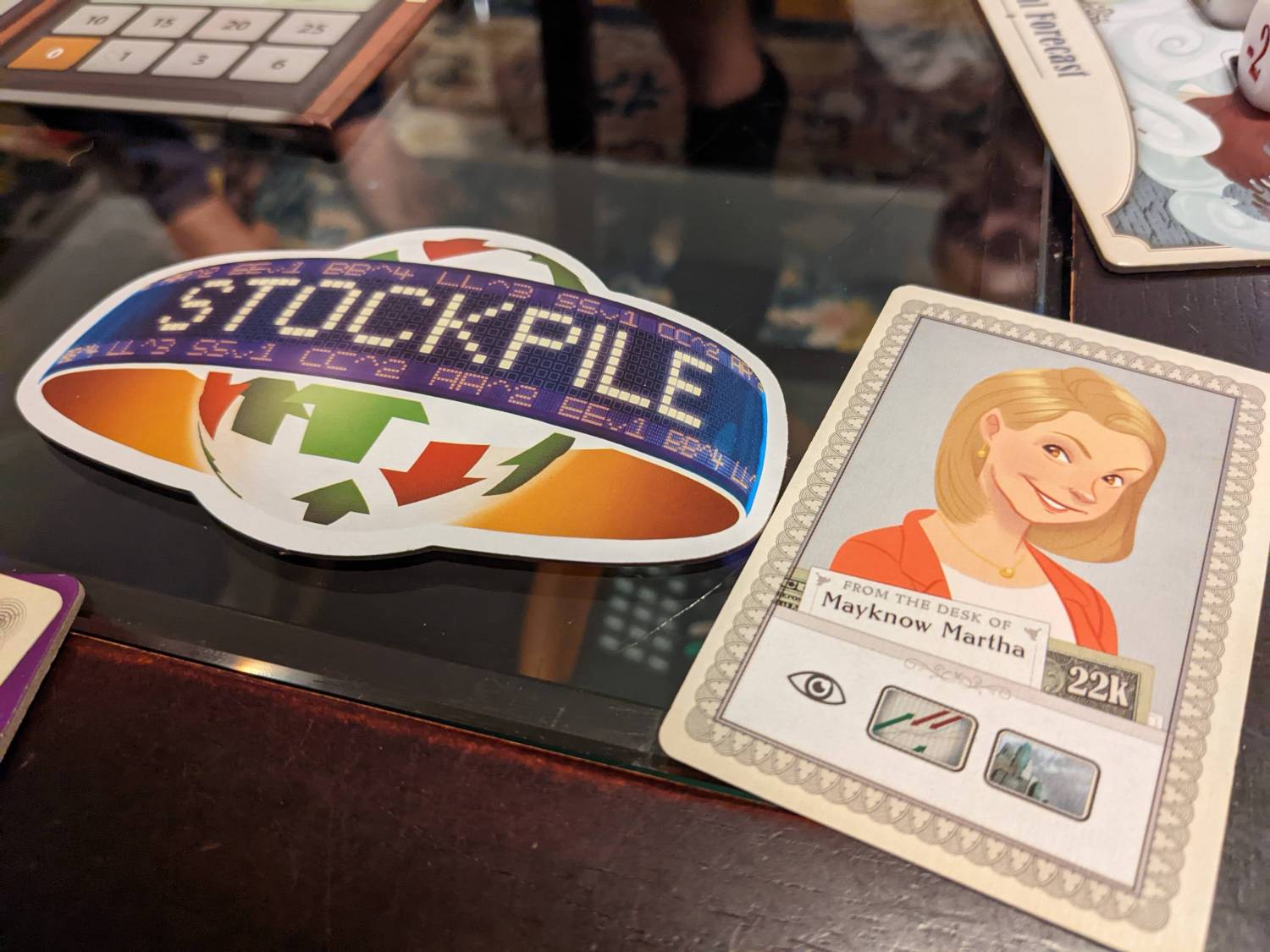
Five or Die, Baby
I have now played Stockpile at three, four, and five-player counts. I’ve never tried it with two players, and I never will. I probably won’t play Stockpile at three players again because I have other economic games (Brick & Mortar comes to mind) that play well at lower player counts.
But at five players, Stockpile becomes the kind of game you’ll tell friends about. The stories are fantastic, the bidding is dramatic, it’s harder to control all the “Majority Shareholder” awards during endgame scoring (handed out to the owner of the most shares of each of the six stocks), and the game still feels rich with fewer rounds.
You can get away with Stockpile at four players, and for a learning game, four is a great time. The other big issue with Stockpile is that the round structure doesn’t feel quite right with four players, or even at three players. In those cases, you don’t play a number of rounds equal to exactly double or triple the player count, meaning that going last (which feels advantageous in Stockpile) is a privilege that is not equally distributed.
In a five-player game, there are exactly five rounds.
Perfect!
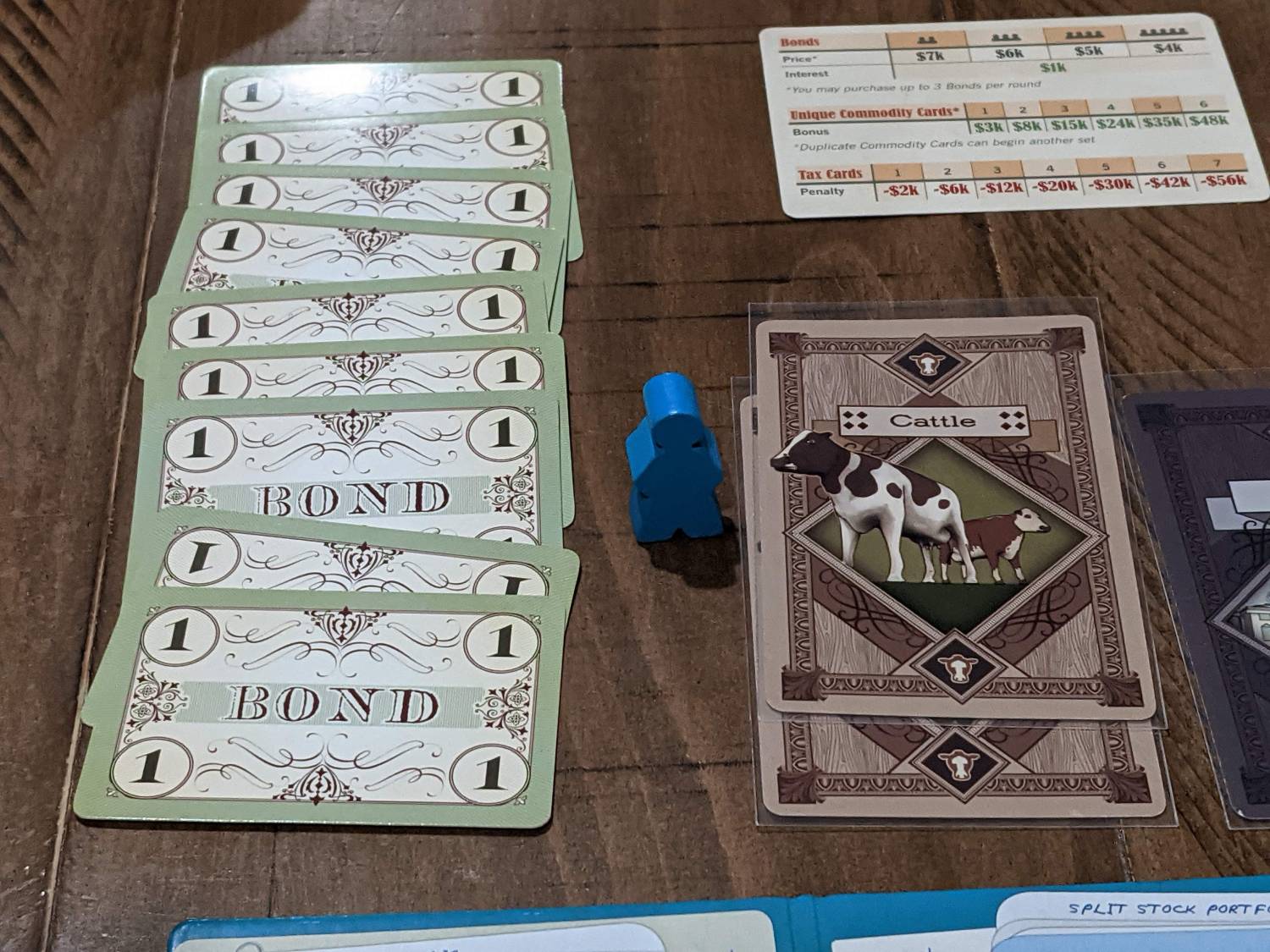
Extensive Expansions
I love Stockpile so much that only for the purposes of this review, I bought my own copy from the Nauvoo web store. I went all-in and bought Stockpile: Epic Edition, featuring all the game’s expansion and promotion content released after the base game was launched in 2015.
Here’s a breakdown of the mini-modules that I’ve played.
Advanced Board
The base game’s board is fine for your first game, but not nearly as volatile as the reverse side of the board. On the advanced side, each of the six companies’ values are different, and in some cases, such as Stanford Steel, completely different in terms of how it works.
It makes some stocks significantly more valuable, while also making the tech stock in the game, Cosmic Computers, comically volatile. Holding shares of Cosmic is always a gamble, in a game that is ostensibly about gambling anyway. For most players, you’ll want to use the advanced side of the board because it is so much fun to see what happens from round to round.
Bonds
I’ve only played with Bonds once, and I’m indifferent on using it again. On the one hand, this expansion’s main mechanic is guaranteed interest income every round that you are holding bonds, so there’s a small drip each turn if you buy them, particularly early on.
On the flip side, this feels like it makes the game friendly, and in a short economic simulation, I’m OK with more cutthroat in terms of approach.
Meh.
Commodities & Taxes
I like the set collection element of most other games, but this is the only expansion in Stockpile: Epic Edition that feels like a board game and not a simulation.
You might win a game of Stockpile with the Commodities & Taxes expansion simply by acquiring stockpiles that happen to have the symbols you need in a Commodity Card set to score massive end-game cash. Stockpile has a healthy element of luck involved anyway (even the theme here aligns with getting lucky in the marketplace), but the Commodity Cards just don’t feel right.
Are the Commodity Cards fun? Absolutely, and they are countered well with the Tax Cards, which can add end-game penalties. This expansion falls into the “more is more” category; it can be added, but I think this one is only for Stockpile purists.
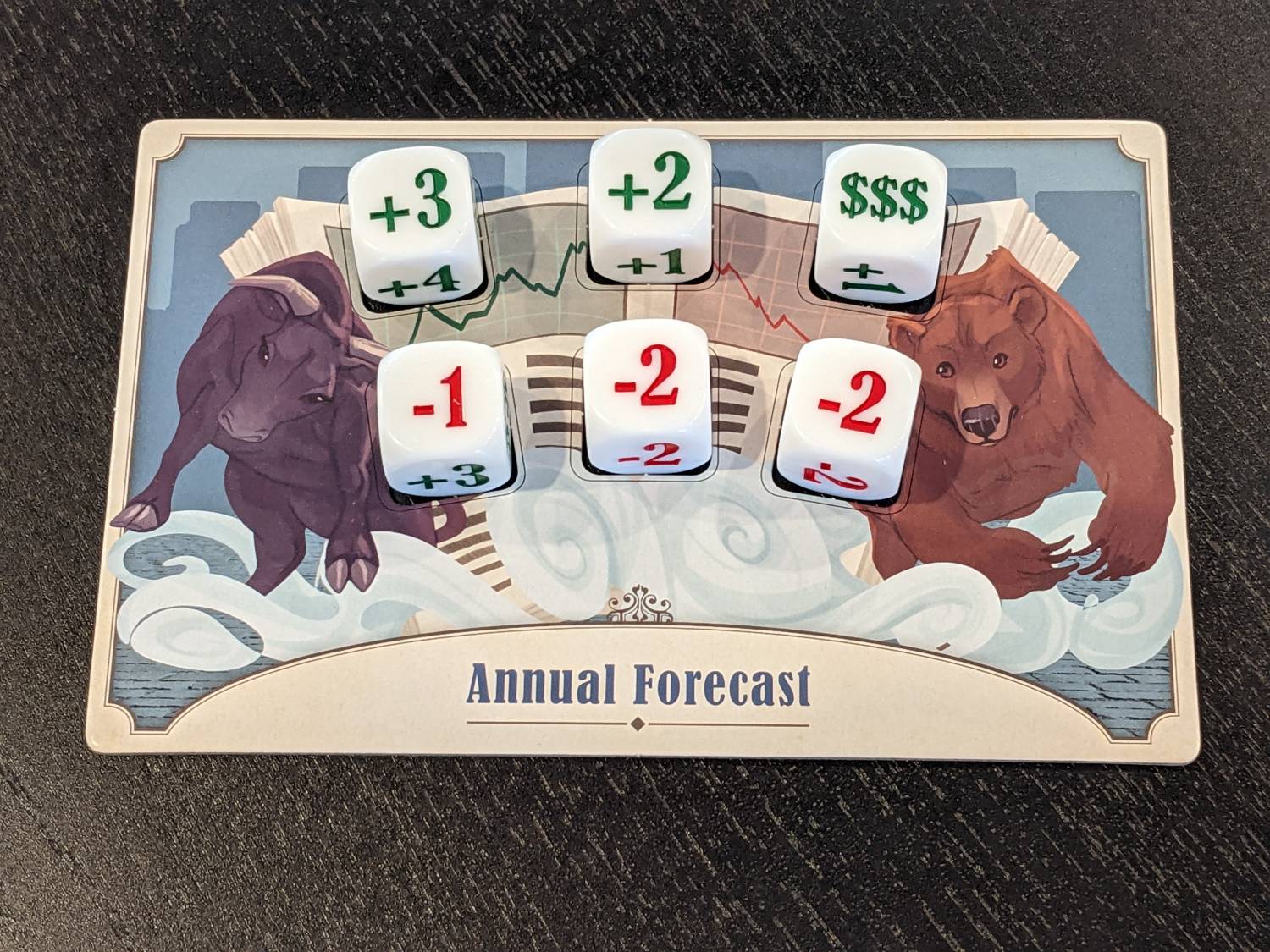
Forecast Dice
I’ll only play Stockpile with the dice, period.
Instead of using the base game’s six Forecast Cards to provide Information during that Phase, someone rolls the six Forecast Dice, which have 22 different sides in total. Whichever six sides get rolled are added into a deck that is used as the Forecast deck for that round, which has a couple of wilder swings high (a +5 is the new high, instead of the +4) and low (-4, instead of a -3).
This can, and will, lead to crazy fun in a couple rounds each game. Forecast Dice is a must.
Investment Strategies
This is the only addition to Stockpile I have not used yet, but I plan to whenever I find a group of experienced Stockpile players (“Stockpilers”, perchance?). Once per Action Phase, players can use one of their five Investment Strategy cards to break the game’s rules, so timing out when to use these cards becomes key.
It’s an interesting way to spice up an already spicy game, but I have so far not felt the need for additional spice because of the second-best expansion for the game after Forecast Dice: Investors.
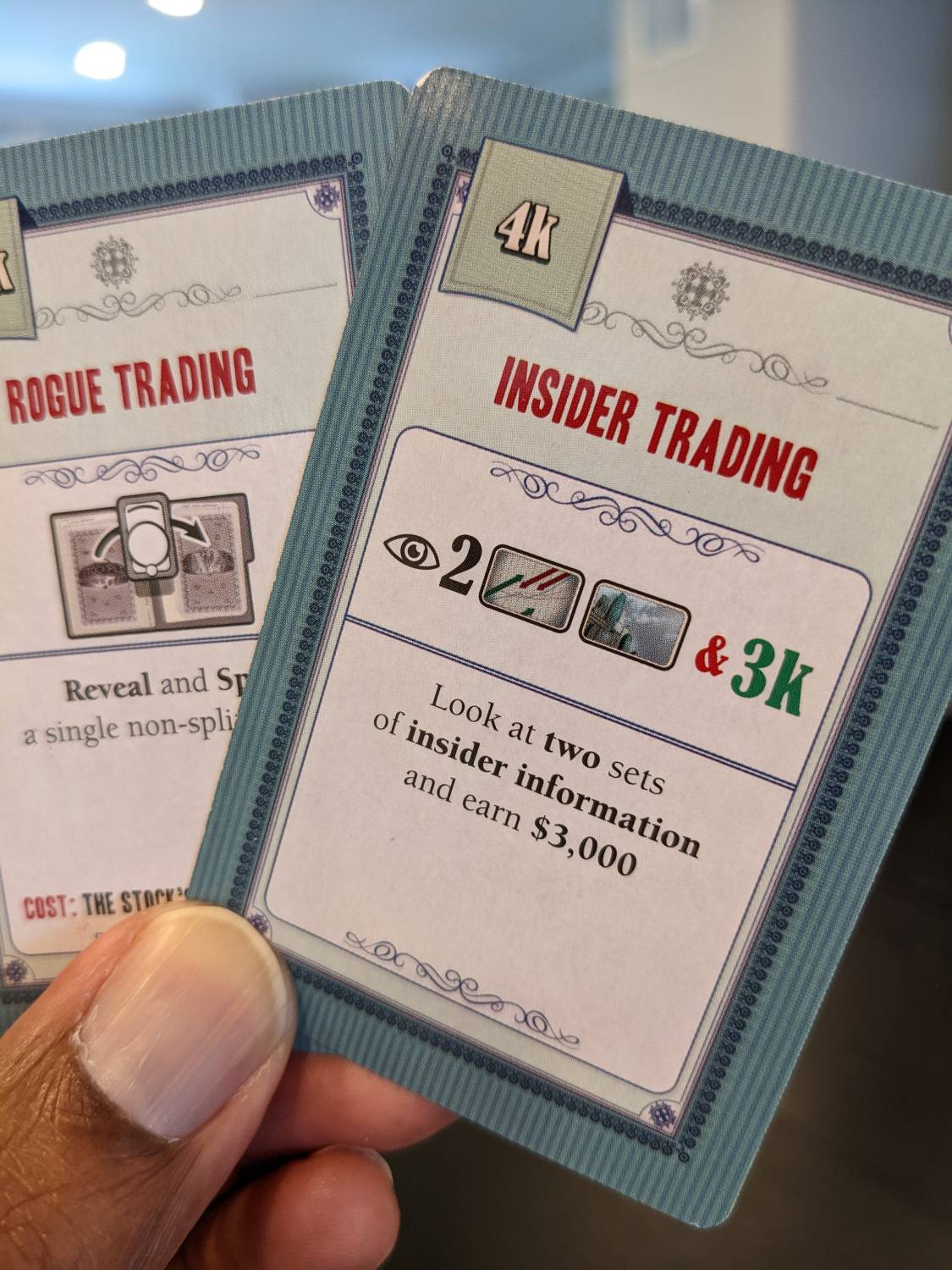
Investors
Variable player powers are in almost every Euro I play these days, but in Stockpile they feel fresh in the ways these powers can break the game’s rules. They also vary how much money each player starts with, whereas in the base game, all players start with $20K.
There are 26 Investor Cards in Stockpile: Epic Edition, compiling all the various expansion Investors and Promo Pack Investors into one deck. Two of these cards are dealt randomly to each player, with everyone choosing one to use as their power for the game.
A couple of the “powers” aren’t powers at all; Billionaire Bill (who looks remarkably similar to someone who used to run Microsoft) just starts the game with a ton of cash. But as the starting salaries of each Investor get lower, their powers usually get better.
Take Moneymaker Mitt, who starts play with only $10K. His power? Every time he bids, or re-bids because of displacement, he gets a grand. EVERY TIME HE BIDS. Mayknow Martha gets to look at one other player’s Forecast and Company Cards each round, doubling the amount of information she has every turn.
In preparation for this review, a player at the table drew Maverick Mark (who, again, looks a LOT like a guy from real life who owns an NBA team in Dallas), and his power might have been the most destructive in the game: before the Demand Phase, Maverick Mark can move one card to a different stockpile, which is the only way to break the game’s base rule that there are enough piles for each player in the game.
(And, of course, it happened: in one of our rounds, one player was left holding the bag and didn’t get any cards. In a shocking twist, that player lost the game.)
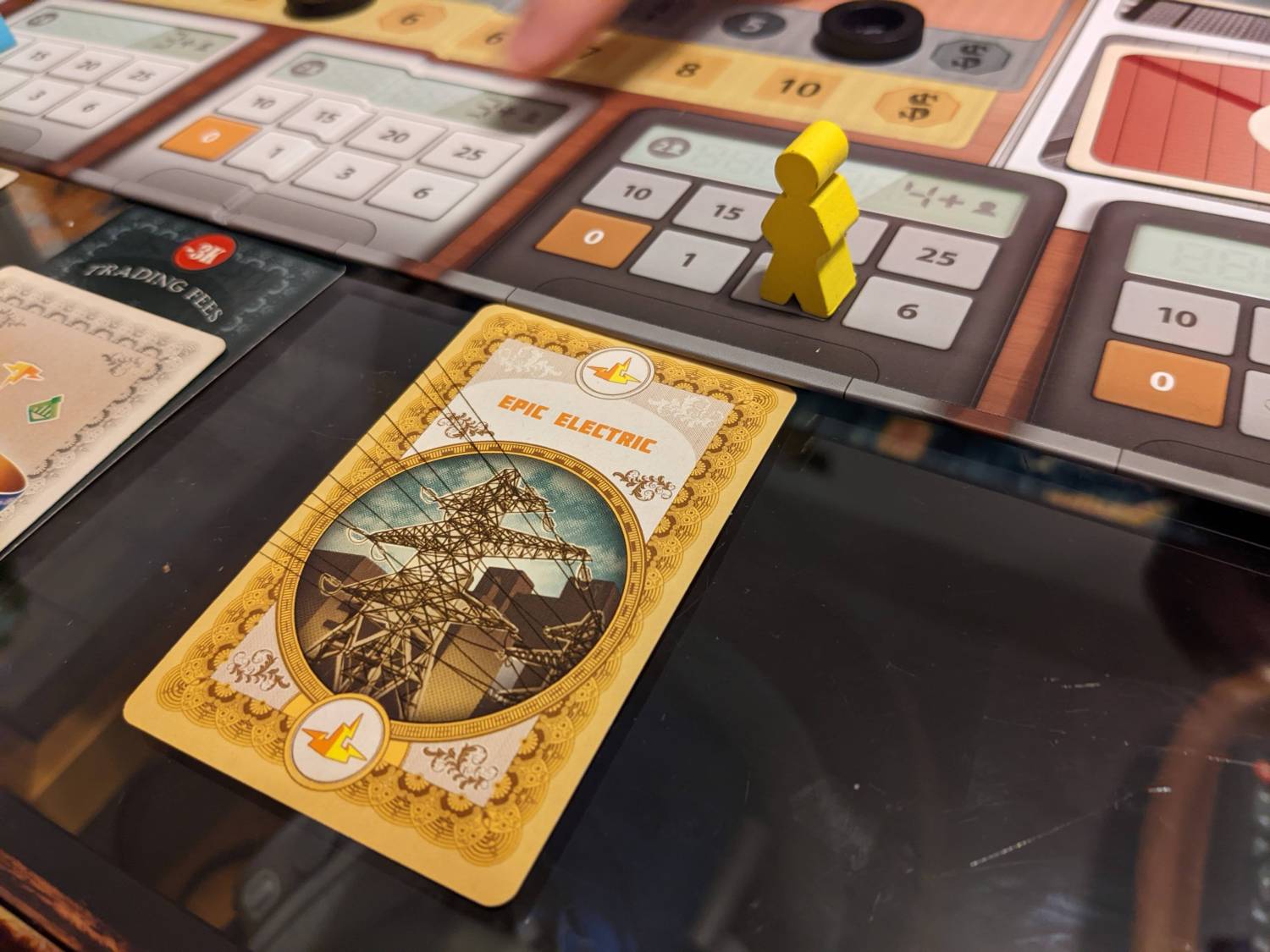
Favorite Fast Five-Player Filler?
Nope. My favorite fast five-player filler is Hansa Teutonica. (I think a filler can be played in under an hour, so for those who think fillers should be shorter, let’s split the difference and go with “long filler” here.)
But Stockpile: Epic Edition is really close, and it shares some similarities with Hansa Teutonica that I find interesting when laying the two games side-by-side:
- Easy to teach
- Light on production, with simple, easy-to-read boards (although I’ll grant that Hansa Teutonica’s iconography is difficult to understand the first time around)
- Even at five players, games last about an hour
Hansa Teutonica gets the edge for me because luck is almost non-existent in its design. Stockpile can swerve badly into runaway leader issues when a player receives stockpiles with face-down cards that happen to be stocks that rise in value over the first round or two. If those split (doubling their value), you are looking at trouble almost right away. I’ve both won and lost games like that over the course of my Stockpile career.
Stockpile: Epic Edition is such a fun experience. Table talk, extensive alliteration (seriously, almost everything in the game is a two-word play such as Cosmic Computers or any of the Investor names), the Investor Cards, wild stock swings, and the Forecast Dice make this a family-weight economic game. Not only do I love it…I like it.
I’m excited to continue playing Stockpile: Epic Edition as a long filler with friends, especially when I can break out the Iron Clays to chuck poker chips around the table.











Add Comment